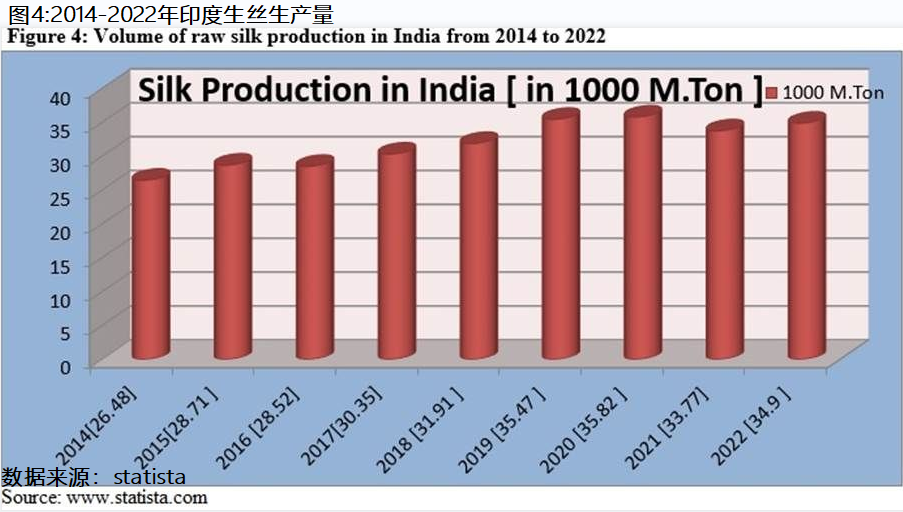

Silk is an expensive textile fibre. India is the second largest silk producer and the largest importer of this raw material in the world. The demand of silk goods is so high that India needs to import large quantity of raw silk to meet the domestic demand. Silk sarees have high domestic demand. India produces four different types of natural silks—mulberry, eri, tasar and muga. Indian silk export items are silk garments, made-ups, fabrics, yarns, carpets and various handmade and handicrafts products. Mulberry silk is the most popular variety of silk produced in India, with Karnataka, Tamil Nadu, Andhra Pradesh, West Bengal and Jammu Kashmir being the major raw silk producing states. Muga is the most expensive silk. Indian silk industry employs a large number of people, who are engaged from raw silk cultivation to production of silk goods and marketing activities.
The share of mulberry silk goods is to the extent of 95 per cent, while other silk items such as tasar and mixed silk fabrics together contributed 5 per cent of India’s total silk export during 1990-2000. The growth rates for quantity and value of export for all mulberry silk goods together were estimated to be 0.49 and 7.98 per cent during the same period. Dress material and readymade garments put together shared 62.37 per cent of total export value during 1990-1991, but their share declined to 60.42 per cent in 2000-2001.
The growth rates of country-wise export earnings showed that Hong Kong, France and Italy were 16.04, 13.95 and 10.00 per cent during the period from 1990-91 to 1999-2000.
The Indian silk export sector has been growing considerably, but it is in a situation where both prospects and problems exist simultaneously. The industry showed an impressive growth in export in last two decades. It is due to the silk exporters’ marketing skills and good understanding of the international markets. In recent years, the Indian Silk Promotion Council has organized Buyer-Seller-Meets (Indian Silk Shows) in countries such as Morocco, Greece, and Lebanon. High quality of indigenous mulberry raw silk and optimum price of imported mulberry raw silk together with good export production and marketing efforts are required to improve the silk export in India.

Figure 1 explains the value of exports from India in the year 2022. Fabric& made-ups and readymade garments had the largest share with export value of $112.41 million and $90.42 million respectively in the year 2022. Silk waste and silk carpets had export value of $28.02 million and $10.63 million respectively. Silk yarn and silk cocoons were the other two silk items exported in the year 2022.

Figure 2 explains that fabrics & made-ups was the largest export item from India in the year of 2021-22, having an export share of 45.29 per cent. Readymade garments and Silk waste were the second and third largest items of silk export having a share of 36.29 per cent and 11.28 per cent respectively. Silk carpets, silk yarn, raw silk and silk cocoons were the other important export items from India during the period.


As per Figure 4, the total quantity of raw silk production increased from 26,480 mt in 2014 to 34,900 mt in 2022. Maximum raw silk production of 35,820 mt was registered in 2020. This is a good sign for the Indian silk industry, as rising trend of raw silk cultivation enhanced the prospects of raw silk production and employability of people in this country.

Figure 4A explains that 4 types of raw silk were produced in this country in 2021-22. Mulberry was the major silk produced with 73.97 per cent of the total silk production. Eri was the second largest type of raw silk at 21.09 per cent. Tasar and muga had a share of 4.2 per cent and 0.73 per cent respectively.

As seen in Figure 4B, mulberry silk was the largest raw silk produced in India having quantity of more than 25,000 mt in 2021-22. The mulberry silk production was much higher in the year 2021-22 compared to 2020-21. Eri was the second largest raw silk production in India at 5,000 mt. The production of tasar silk decreased in 2021-22 compared to 2020-21.



